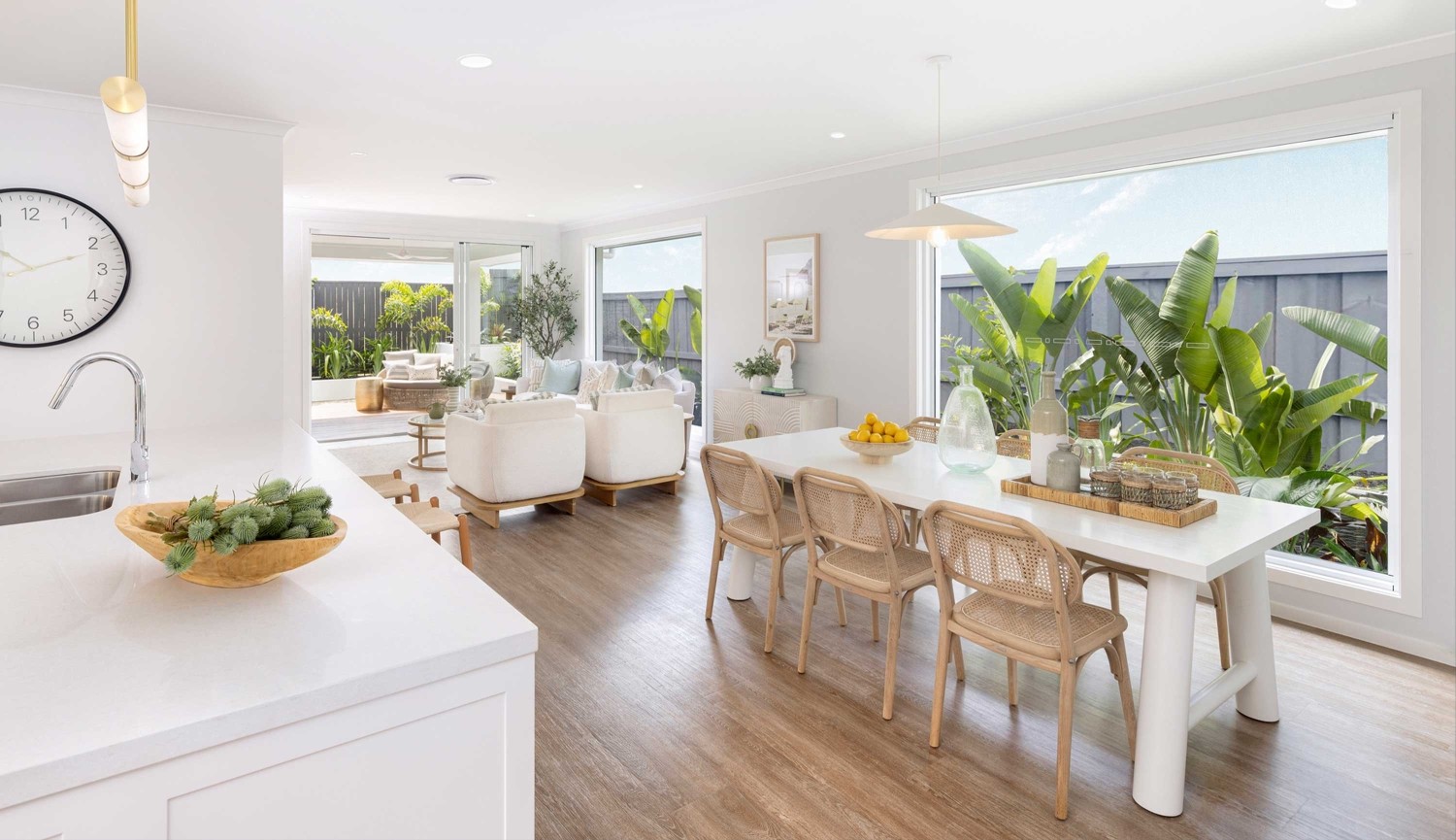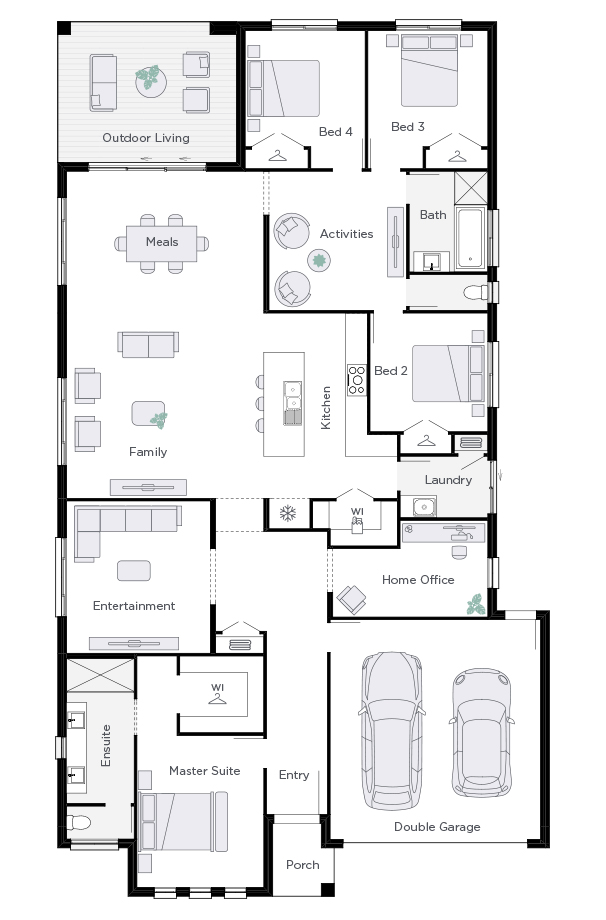How to Read a Floor Plan

If you are planning on building or buying a new home, you’ll want to learn how to read a floor plan. Architects and designers create floor plans to be an in-scale representation of the property’s rooms, spaces and physical features. For first-time home builders especially, floor plans can help you visualise the finished product and ensure it includes everything you want in a house.
From getting to grips with room dimensions to understanding electrical plans and the general home layout, here’s what you need to know about reading floor plans.
What is a floor plan?
A floor plan is a two-dimensional representation of a building's layout. It gives you a bird’s-eye view of a single level, illustrating the arrangement and proportions of all the various rooms, walls, windows, doors and other architectural features that make up the home. Floor plans act as a helpful visual guide for all parties – not just the owner, but for builders, architects and designers as well. As a future home owner, it will give you all the information you need to better understand the layout and flow of the property.
Floor plans can vary in complexity and level of detail. While some floor plans focus solely on the layout of a house's rooms and walls, others may include more detailed information like furniture placement, electrical and plumbing systems, as well as structural elements. Ultimately, the level of detail in a floor plan will depend on its intended use and who it’s created for.
What Details can you get from a Floor Plan?
Floor plans are construction drawings that will include a wealth of information about a home's design and functionality. By examining a floor plan, you can gain a greater appreciate for the:
- Room layout: Floor plans visualise each room’s layout in great detail, showing the placement of bedrooms, bathrooms, kitchen, living areas and other spaces. You can picture how the rooms are interconnected and see their exact sizes (to scale).
- Flow and traffic patterns: A fully functional home is one that flows well from space to space. By studying the floor plan, you can identify how people will move through the property to ensure smooth transitions and efficient use of all areas.
- Architectural features: Floor plans show you architectural features like windows, doors, staircases and fireplaces. These details will help you assess where natural light will come from, as well as ventilation and other focal points within the home.
- Storage space: All floor plans will indicate where storage areas are, such as built-in/walk-in wardrobes, pantries, cupboards, cabinets and linen closets. This information can help you determine whether there is enough built-in storage for the property.
- Outdoor areas: In addition to the interior, floor plans often include details about outdoor areas such as decks, verandahs and balconies. This gives you a better idea of how much outdoor living space there is and how it connects to your indoor areas.

What can't a Floor Plan tell you about a home?
Now that you understand the basics of what you will – and won’t – find in a floor plan, let's explore the keep steps on how to read a floor plan effectively:
- Interior design: Because floor plans explicitly focus on the architectural layout and spatial relationships, there’s no way to showcase the interior design elements. So you won’t get to see things like the colour schemes or small details like ceiling roses.
- Finishes and materials: There’s generally no information about the specific finishes and materials used in the construction of a house. Details such as the type of flooring installed, countertop materials and wall finishes won’t be included.
- Elevation and façade: Don’t expect to find details about the exterior appearance or elevation of the property. The architectural style, façade materials and outdoor aesthetics are usually not included in a floor plan.
How to read a Floor Plan
Now that you understand the basics of what you will – and won’t – find in a floor plan, let's explore the keep steps on how to read a floor plan effectively:
- Orientation: Start by identifying the correct orientation of the floor plan. Look for a compass symbol (i.e. compass rose) or north arrow which will point in the direction of north. This will help you better understand how the plan aligns with the actual site.
- Scale: The scale of the architectural plans is usually printed in one of the corners. This represents the ratio between the dimensions on the plan and the actual measurements of the building. Common scales are 1:50 or 1:100 (1 centimetre = 1 metre). It can help you better visualise the square footage or square metres of the home’s interior.
- Room labels: Pay attention to the labels assigned to each room. For example, "Master Suite" will indicate the master bedroom, while "WI" will be in reference to a walk-in wardrobe.
Common Floor Plan Symbols
Common symbols used in floor plans will give you a better understanding of the most important architectural features and elements within the house.
| DoorsDoor symbols are typically represented by a straight line with a perpendicular line indicating the swing direction |
| WindowsWindows are commonly depicted as a line with a series of smaller lines of squares representing panes of glass. the size and shape of the window symbol may vary based on the type of window installed (e.g. casement, sliding, double hung, etc.) |
| Number of carsIf a floor plans includes a garage or carport, it will typically be represented by a rectangle with a car symbol (or multiple cars) inside it. |
| BedsBedrooms are commonly represented with bed symbols inside them. Pay attention to the location and size of the bedroom symbol to understand the actual size of the space. |
| Bathroom FixturesBathrooms are usually easy to find because they include a toilet symbol inside them. There may also be markings to indiciate the presense of a sink, shower or bathtub. |
| Dining tablesDining areas or dining rooms are often represented with a table symbol surrouned by chairs. In some cases, the symbols may include additional markings to indiciate other complementary furniture
|
| Built In AppliancesIf the floor plan includes built in appliances, such as ovens, stovetops, fridges and dishwashers, they are typically depicted with symbols that clearly resemble the shape of the appliance installed. |
| Built in storage and walk in robesBuilt in storage areas, such a closets or wardrobes, are usually depicted as rectangles with small lines of symbols inside, representing shelves, rods or drawers. Brighton Homes floor plans use a coat hanger to indiciate these spaces |
| Outdoor ElementsOutdoor elements, such as outdoor living areas, balconies or garden areas, may be included in the floor plan. These are often shown with darker shading to differentiate them from the interior spaces, as well as exterior walls, furniture and plant symbols. |
Size and Measurement
If you want to truly visualise the actual space of your property, you’ll need to understand how to read floor plan measurements. Here are a few tips:
- Room dimensions: Each room on the floor plan should include dimensions, typically represented by arrows or lines indicating the length or width of the space. Otherwise there will be a measurement key (to scale) somewhere on the house plans which you can use to calculate the dimensions of each room.
- Ceiling height: Check if the site plans have information about the ceiling height. This will give you an overall sense of the spaciousness, as well as indicate if there are any differences in height throughout the property.
- Total square metres: Look for the total square metres of the house, usually mentioned somewhere on the floor plan. This figure is in addition to the size of the land.
- Furniture placement: Consider the room sizes and layout of each space. The dimensions provided will be particularly useful in helping you figure out how and where your furniture will fit.
- Traffic flow: Consider the placement of hallways and doorways to picture how people will move through the home. Think about whether the current layout allows for easy movement between rooms and if there are any potential bottlenecks.
Knowing how to read a floor plan is an incredibly valuable skill for first-time home builders who want to understand more about their future home’s layout, functionality and flow. You’ll find a detailed floor plan for every Brighton Homes design, allowing you to make an informed decision when choosing your dream home.
